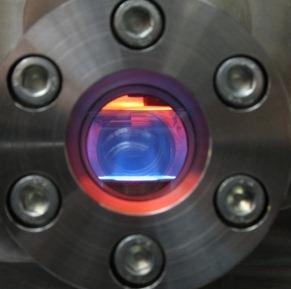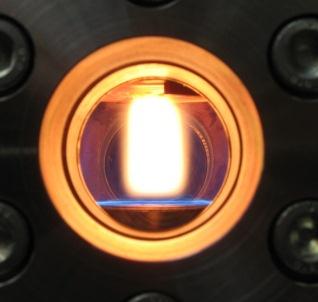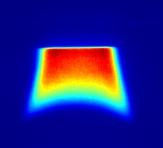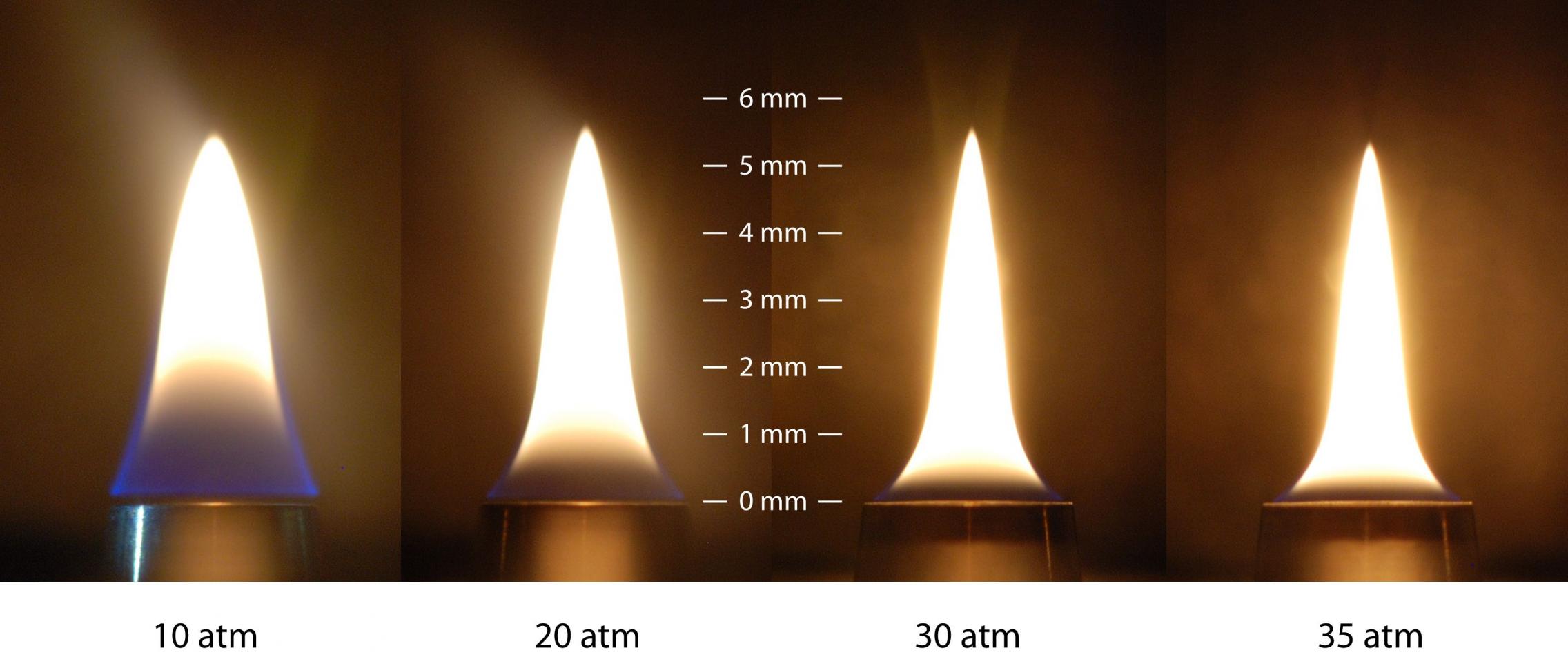Pressurised Flames and Sprays
Use of one or more of the different target flames is encouraged as those use ethylene as fuel, which sooting chemistry is currently better known than that of other fuels.
Preference is given to those flames on top of the site. Second priority for validating soot models in the "pressurised flames and spray" session have the well characterized laminar flames below "other flames".
Please note that most data sets are maintained from ISF 2 at modified order, while the initial data set named “swirled pressurized” got replaced by a more comprehensive one.
The pressurised flames and sprays section has now been incorporated under laminar and turbulent. Please see the relevant call for contributions section on the data page.
-
ISF-3 target flame 2: laminar diffusion pressurised
Highest preference in this flame series has the 4 bar case with most comprehensive data available.

KAUST diffusion pressurized
This data set contains data for atmospheric conditions (no soot) thus links to laminar flames session.Flow and operating conditions:
- Pressure range for soot volume fraction and particle size: 4 - 16 atm
- Pressure range for temperature: 1 - 4 atm
- Pressure range for species: 1 - 16 atm
- Fuel mass flow: 1.37 mg/s ethylene, 6.41 mg/s nitrogen
- Co-flow mass flow for fv, D63, and dp: 1.25, 2.51, 4.01, 4.42 g/s air at 4, 8, 12, and 16 atm, respectively
- Co-flow mass flow for temperature and species: 1.25 g/s for 1-8 atm, 1.32 g/s for 12 and 16 atm
Dimensions for soot volume fraction and particle size:
Fuel tube ID is 4.0 mm. The 6.1 mm OD is tapered from 5 mm below fuel nozzle exit to the tip. A 100 ppi carbon foam 8 mm in length is placed inside the fuel nozzle 8 mm below the nozzle tip. The co-flow diameter is 50 mm and contains a honeycomb with 1 mm channels that ends 5 mm below fuel nozzle tip.
Dimensions for temperature and species:
Fuel tube ID is 4.0 mm. The 6.35 mm OD is tapered from 5 mm below fuel nozzle exit to the tip. Steel wool is placed inside the fuel nozzle 8 mm below the nozzle tip. The co-flow contains a 100 ppi aluminium foam which ends 5 mm below the fuel nozzle tip. For 1-8 atm, the co-flow diameter is 50 mm, and for 12 and 16 atm, the co-flow diameter is 25 mm.
Measurements:
- Soot volume fraction (fv) and particle size (D63 and dp) by line of sight attenuation and scattering. Df = 1.7, kf = 2.4.
- Temperature by thermocouple measurement, species by gas extraction via quartz probe and GC analysis
Reference for soot, temperature and species:
dx.doi.org/10.1016/j.combustflame.2012.11.004
dx.doi.org/10.1016/j.proci.2012.06.148
dx.doi.org/10.1016/j.combustflame.2016.02.034
Contact:
Prof. Willam RobertsSoot volume fraction measurement
-
ISF-3 target flame 3: laminar premixed pressurised 1

Image: Duisburg premixed pressurised
This data set contains data for atmospheric conditions (no soot), thus links to laminar flames session.Flow and operating conditions
Pressure range: 0.1 - 3.0 MPaDimensions:
Three concentric burner plates (sintered material) for stabilizing a laminar sooting flame in the centre shielded by an annular non-sooting rich flame and an air coflow. The housing and the flanges are water cooled. Multiple optical ports allow the application of various optical diagnostics techniques.
- Diameter of inner burner: 20 mm
- Diameter of fresh gas tube: 22 mm
- Diameter of surrounding burner: 26 × 56 mm
- Diameter of coflow: 60 × 86 mm
- Detailed 3D-CAD files are available!
- Visible flame heights: ~ 1 mm
- Visible sooting exhaust gas height: > 40 mm fixed equivalence ratio of ɸ=2.1

Image: Duisburg premixed pressurised
This data set contains data for atmospheric conditions (no soot), thus links to laminar flames session.Measurements:
- Laser induced incandescence (TiRe-LII)CMD, fv
- Excitation @ 1064 nm, detection @ 550/694 nm
- Laser extinction @ 785 nm fv
- Particle sampling & TEM evaluation CMD
- Spectrally resolved black body radiation Tgas
Locations:
All diagnostics have been applied at 15 mm HAB for 18 different pressures, several additional measurement locations have been studied in addition with some of the diagnosticsNote: LII signal suffers from attenuation, thus fv determined by LII deviates from that by extinction, being the more reliable measure for increased pressure/soot concentrations
Fuel:- Ethylene (C2H4) for sooting flames
- Non-sooting flames with ethylene, methane, propene
- Other gaseous fuels are possible
References:
M. Hofmann, B.F. Kock, T. Dreier, H. Jander, C. Schulz: Appl. Phys. B 90, 629 (2008)Data is available on request from the email addresses below:
Prof. Dr. Christof Schulz
Dr. Thomas Dreier -
ISF-3 target flame 4: laminar premixed pressurised 2

This data set contains data for atmospheric conditions, thus links to laminar flames session.
Flow and operating conditions
Pressure Range: 0.1 – 0.5 MPa
Dimensions:
The central, sooting flame (ethylene/air) was stabi¬lized above a water-cooled sintered bronze matrix. This flame is surrounded by a non-sooting “shielding flame” of methane/air (varying ɸ). The flames were surrounded by an air coflow. The diameters of the central matrix, shielding matrix, and coflow duct were 41.3 mm, 61.3 mm, and 150 mm, respectively.
Conditions:
Pressure: 3 bar
ɸ = 2.3 (C/O=0.766)
ɸ = 2.5 (C/O=0.834)Pressure: 3 bar
ɸ = 2.05 (C/O=0.683)
ɸ = 2.4 (C/O=0.8)Measurements:
- Laser induced incandescence
- Shifted vibrational CARS
Fuel: Ethylene (C2H4) / air mixture for central flame.
References:
M.S. Tsurikov et al., Comb. Sci. Technol. 177 (2005) 1835-1862
-
ISF-3 other flame 1: pressurised laminar diffusion C2H6

Flow and operating conditions:
- Pressure range: 0.2 - 3.34 MPa
- Fuel (ethylene) mass flow: 0.00052 g/s
- Co-flow mass flow: 0.12g/s for 0.2-2.53MPa, 0.24g/s for 3.04-3.34MPa
- Visible flame heights: ~ 10 mm
Dimensions:
Fuel tube exit is tapered for a distance of 5 mm on both sides. There is sintered foam in the tube prior to the start of the taper.
- Starting inner fuel tube diameter: 2.29 mm
- Exit inner fuel tube diameter : 3.06 mm
- Starting outer fuel tube diameter: 4.76 mm
- Exit outer fuel tube diameter: 3.06 mm
There is sintered foam in the air tube at a distance of 14.7 mm below the exit plane of the fuel tube.
- Air tube inner diameter : 25 mm
Reference for complete burner geometry:
P. Mandatori, Soot formation in ethane-air coflow laminar diffusion flames at elevated pressures, Master's thesis, University of Toronto,
Toronto, Canada (2006).Measurements:
Soot volume fraction and temperature by spectral soot emission (SSE) diagnostics.Reference:
Mandatori et al. (2011), Proc. Combust. Inst, 33:577-584Contact: Professor Ömer Gülder
-
ISF-3 other flame 2: pressurised laminar diffusion CH4

Image: Methane-Air Gülder
Flow and operating conditions:
- Pressure range: 1.0 - 6 MPa
- Fuel (CH4) mass flow: 0.00055 g/s
- Co-flow mass flow: 0.4 g/s for lower pressures, 0.8g/s for higher pressures
- Fuel temperature: 294 +/- 3K
- Air temperature: 294 +/- 3K
- Visible flame heights: ~ 9 mm
Dimensions:
Fuel tube exit is tapered for a distance of 5 mm on both sides. There is sintered foam in the tube prior to the start of the taper.- Starting inner fuel tube diameter: 2.29 mm
- Exit inner fuel tube diameter: 3.06 mm
- Starting outer fuel tube diameter: 4.76 mm
- Exit outer fuel tube diameter: 3.06 mm
There is sintered foam in the air tube at a distance of 14.7 mm below the exit plane of the fuel tube.
- Air tube inner diameter: 25 mm
Reference for complete burner geometry:
P. Mandatori, Soot formation in ethane-air coflow laminar diffusion flames at elevated pressures, Master's thesis, University of Toronto, Toronto, Canada (2006)Measurements:
Soot volume fraction and temperature by spectral soot emission (SSE) diagnosticsDownload the data file
References:
- D.R. Snelling et al. AIAA Journal, Vol. 40, No. 9, September 2002
- H.I. Joo et al. Proceedings of the Combustion Institute, Vol. 32, 2009, pages 769-775
- M.R.J. Charest et al., Combustion and Flame, Vol. 158, 2011, pages 860-875
Contact: Professor Ömer Gülder
